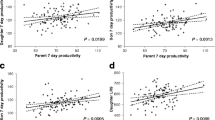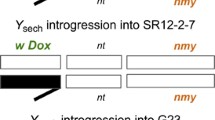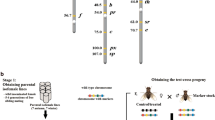Abstract
Reciprocal cross effects (i.e., differences between reciprocal hybrids that are developed by reversing the strains from which the dam and the sire are taken) are commonly used as a measure of sex-linkage or maternal effects. However, the papers reporting parental effects on life span of experimental animals are scarce. In order to investigate the potential of parent-of-origin effects for the longevity of hybrids, we determined the life spans of the inbred lines of Drosophila melanogaster [Oregon-R (OR), Canton-S (CS) and Uman (Um)] that differ significantly in longevity, as well as the life span of the progeny from the reciprocal crosses among them. The hybridization caused the increase in both flies’ mean and maximum life span mainly shifting the survival curves upward proportionally at all ages. This resulted in the reduction in the Gompertz intercept (frailty) whereas the Gompertz slope (the rate of aging) was predominantly unchanged. Better-parent heterosis was observed in hybrids between OR and Um inbred lines and the extent of heterosis was more pronounced in hybrids between CS and Um inbred lines if long-lived parent was used as the female parent, and short-lived parent was used as the male parent in the crossing scheme. Such discrepancy in life span between reciprocal crosses may indicate that non-chromosomal factors are significantly contributing to a heterotic response. Our data are in line with the previous reports suggesting the involvement of non-genomic factors, particularly epigenetic events attributed to hybridization, in the manifestation of heterosis.




Similar content being viewed by others
References
Ashburner M, Golic K, Hawley S (2004) Drosophila: a laboratory handbook. CSHL Press, Woodbury
Baranwal VK, Mikkilineni V, Zehr UB, Tyagi AK, Kapoor S (2012) Heterosis: emerging ideas about hybrid vigour. J Exp Bot 63:6309–6314
Birchler JA, Auger DL, Riddle NC (2003) In search of the molecular basis of heterosis. Plant Cell 15:2236–2239
Birchler JA, Yao H, Chudalayandi S, Vaiman D, Veitia RA (2010) Heterosis. Plant Cell 22:2105–2112
Bregliano JC, Laurençon A, Degroote F (1995) Evidence for an inducible repair–recombination system in the female germ line of Drosophila melanogaster. I. Induction by inhibitors of nucleotide synthesis and by gamma rays. Genetics 141:571–578
Cakir S, Bozcuk AN (2000) Longevity in some wild type and hybrid strains of Drosophila melanogaster. Turk J Biol 24:321–329
Chen ZJ (2010) Molecular mechanisms of polyploidy and hybrid vigor. Trends Plant Sci 15:57–71
Clark ME, Anderson CL, Cande J, Karr TL (2005) Widespread prevalence of Wolbachia in laboratory stocks and the implications for Drosophila research. Genetics 170:1667–1675
Clarke JM, Maynard Smith J (1955) The genetics and cytology of Drosophila subobscura. XI. Hybrid vigor and longevity. J Genet 53:172–180
Comings DE, MacMurray JP (2000) Molecular heterosis: a review. Mol Genet Metab 71:19–31
Ding D, Wang Y, Han M, Fu Z, Li W, Liu Z, Hu Y, Tang J (2012) MicroRNA transcriptomic analysis of heterosis during maize seed germination. PLoS ONE 7:e39578
Dobzhansky T (1935) Maternal effect as a cause of the difference between the reciprocal crosses in Drosophila pseudoöbscura. Proc Natl Acad Sci USA 21:443–446
Dobzhansky T, Sturtevant AH (1935) Further data on material effects in Drosophila pseudoöbscura hybrids. Proc Natl Acad Sci USA 21:566–570
Economos AC, Lints FA (1984) Growth rate and life span in Drosophila. I. Methods and mechanisms of variation of growth rate. Mech Ageing Dev 27:1–13
Fitch KR, Yasuda GK, Owens KN, Wakimoto BT (1998) Paternal effects in Drosophila: implications for mechanisms of early development. Curr Top Dev Biol 38:1–34
Fry AJ, Rand DM (2002) Wolbachia interactions that determine Drosophila melanogaster survival. Evol Int J Org Evol 56:1976–1981
Fry AJ, Palmer MR, Rand DM (2004) Variable fitness effects of Wolbachia infection in Drosophila melanogaster. Heredity 93:379–389
Gonzalo M, Vyn TJ, Holland JB, McIntyre LM (2007) Mapping reciprocal effects and interactions with plant density stress in Zea mays L. Heredity (Edinb) 99:14–30
Greer EL, Maures TJ, Ucar D, Hauswirth AG, Mancini E, Lim JP, Benayoun BA, Shi Y, Brunet A (2011) Transgenerational epigenetic inheritance of longevity in Caenorhabditis elegans. Nature 479:365–373
Groszmann M, Greaves IK, Albert N, Fujimoto R, Helliwell CA, Dennis ES, Peacock WJ (2011a) Epigenetics in plants—vernalisation and hybrid vigour. Biochim Biophys Acta 1809:427–437
Groszmann M, Greaves IK, Albertyn ZI, Scofield GN, Peacock WJ, Dennis ES (2011b) Changes in 24-nt siRNA levels in Arabidopsis hybrids suggest an epigenetic contribution to hybrid vigor. Proc Natl Acad Sci USA 108:2617–2622
Ho DH, Burggren WW (2010) Epigenetics and transgenerational transfer: a physiological perspective. J Exp Biol 213:3–16
Hofmann NR (2012) A global view of hybrid vigor: DNA methylation, small RNAs, and gene expression. Plant Cell 24:841
Hughes KA (1995) The inbreeding decline and average dominance of genes affecting male life-history characters in Drosophila melanogaster. Genet Res 65:41–52
Ilinsky Y (2013) Coevolution of Drosophila melanogaster mtDNA and Wolbachia genotypes. PLoS ONE 8:e54373
Jensen PA, Stuart JR, Goodpaster MP, Goodman JW, Simmons MJ (2008) Cytotype regulation of P transposable elements in Drosophila melanogaster: repressor polypeptides or piRNAs? Genetics 179:1785–1793
Kaeppler S (2012) Heterosis: many genes, many mechanisms—end the search for an undiscovered unifying theory. ISRN Bot 2012:12
Khurana JS, Wang J, Xu J, Koppetsch BS, Thomson TC, Nowosielska A, Li C, Zamore PD, Weng Z, Theurkauf WE (2011) Adaptation to P element transposon invasion in Drosophila melanogaster. Cell 147:1551–1563
Kidwell MG (1983) Evolution of hybrid dysgenesis determinants in Drosophila melanogaster. PNAS 80:1655–1659
Konac T, Bozcuk AN, Kence A (1995) The effect of hybrid dysgenesis on life span of Drosophila. Age 18:19–23
Lemaitre B, Ronsseray S, Coen D (1993) Maternal repression of the P element promoter in the germline of Drosophila melanogaster: a model for the P cytotype. Genetics 135:149–160
Li A, Fang MD, Song WQ, Chen CB, Qi LW, Wang CG (2012) Gene expression profiles of two intraspecific Larix lines and their reciprocal hybrids. Mol Biol Rep 39(4):3773–3784
Lippman ZB, Zamir D (2007) Heterosis: revisiting the magic. Trends Genet 23:60–66
Madlung A, Comai L (2004) The effect of stress on genome regulation and structure. Ann Bot 94:481–495
Martinez AO, McDaniel RG (1981) Heterosis for H1 histone content in aging Drosophila hybrids. Mech Ageing Dev 17:141–150
McClintock B (1984) The significance of responses of the genome to challenge. Science 226:792–801
Melchinger AE (1999) Genetic diversity and heterosis. In: Coors JG, Staub JE (eds) The genetics and exploitation of heterosis and crop plants. Crop Science Society of America, Madison, pp 99–118
Meyer RC, Witucka-Wall H, Becher M, Blacha A, Boudichevskaia A, Dörmann P, Fiehn O, Friedel S, von Korff M, Lisec J, Melzer M, Repsilber D, Schmidt R, Scholz M, Selbig J, Willmitzer L, Altmann T (2012) Heterosis manifestation during early Arabidopsis seedling development is characterized by intermediate gene expression and enhanced metabolic activity in the hybrids. Plant J 71:669–683
Min KT, Benzer S (1997) Wolbachia, normally a symbiont of Drosophila, can be virulent, causing degeneration and early death. Proc Natl Acad Sci USA 94:10792–10796
Moll RH, Lonnquist JH, Fortuno JV, Johnson EC (1965) The relationship of heterosis and genetic divergence in maize. Genetics 52:139–144
Mousseau TA, Dingle H (1991) Maternal effects in insect life histories. Annu Rev Entomol 36:511–534
Mousseau TA, Uller T, Wapstra E, Badyaev AV (2009) Evolution of maternal effects: past and present. Phil Trans R Soc B 364:1035–1038
Paun O, Fay MF, Soltis DE, Chase MW (2007) Genetic and epigenetic alterations after hybridization and genome doubling. Taxon 56:649–656
Pletcher SD, Khazaeli AA, Curtsinger JW (2000) Why do life spans differ? Partitioning mean longevity differences in terms of age-specific mortality parameters. J Gerontol A Biol Sci Med Sci 55:B381–B389
Poulson DF (1934) Times of development of the two races of Drosophila pseudoobscura. J Exp Zool 68:237–245
Promislow DEL, Tatar M, Pletcher S, Carey JR (1999) Below threshold mortality: implications for studies in evolution, ecology and demography. J Evol Biol 12:314–328
Rand DM, Fry A, Sheldahl L (2006) Nuclear-mitochondrial epistasis and Drosophila aging: introgression of Drosophila simulans mtDNA modifies longevity in D. melanogaster nuclear backgrounds. Genetics 172:329–341
Riddle NC, Jiang H, An L, Doerge RW, Birchler JA (2010) Gene expression analysis at the intersection of ploidy and hybridity in maize. Theor Appl Genet 120:341–353
Riegler M, Sidhu M, Miller WJ, O’Neill SL (2005) Evidence for a global Wolbachia replacement in Drosophila melanogaster. Curr Biol 15:1428–1433
Robertson HM, Engels WR (1989) Modified P elements that mimic the P cytotype in Drosophila melanohgaster. Genetics 123:815–824
Ronsseray S, Lehmann M, Anxolabehere D (1989) Copy number and distribution of P and I mobile elements in Drosophila melanogaster populations. Chromosoma 98:207–214
Shen H, He H, Li J, Chen W, Wang X, Guo L, Peng Z, He G, Zhong S, Qi Y, Terzaghi W, Deng XW (2012) Genome-wide analysis of DNA methylation and gene expression changes in two Arabidopsis ecotypes and their reciprocal hybrids. Plant Cell 24:875–892
Spencer CC, Promislow DE (2005) Age-specific changes in epistatic effects on mortality rate in Drosophila melanogaster. J Hered 96:513–521
Swindell WR, Bouzat JL (2006) Inbreeding depression and male survivorship in Drosophila: implications for senescence theory. Genetics 172:317–327
Toivonen JM, Walker GA, Martinez-Diaz P, Bjedov I, Driege Y, Jacobs HT, Gems D, Partridge L (2007) No influence of Indy on lifespan in Drosophila after correction for genetic and cytoplasmic background effects. PLoS Genet 3:e95
Vaiserman AM (1992) Biological age and life span of the various lines of Drosophila melanogaster by the experimental modifications of the rate of aging. PhD dissertation, Institute of Gerontology, Kiev [In Russian]
Vaiserman AM (2011) Hormesis and epigenetics: is there a link? Ageing Res Rev 10:413–421
Vaiserman AM (2012) Transgenerational inheritance of longevity: an epigenetic phenomenon? J Gerontol Geriatr Res 1:e116
Valtonen TM, Roff DA, Rantala MJ (2011) Analysis of the effects of inbreeding on lifespan and starvation resistance in Drosophila melanogaster. Genetica 139:525–533
Veitia RA, Vaiman D (2011) Exploring the mechanistic bases of heterosis from the perspective of macromolecular complexes. FASEB J 25:476–482
Vermeulen CJ, Bijlsma R (2004) Changes in mortality patterns and temperature dependence of lifespan in Drosophila melanogaster caused by inbreeding. Heredity (Edinb) 92:275–281
Walton A, Hammond J (1938) The maternal effects on growth and conformation in Shire horse–Shetland pony crosses. Proc R Soc Lond B 125:311–335
Woodhams CA, Hollingsworth MJ (1971) The longevity of first and second generation Drosophila hybrids. Exp Gerontol 6:43–48
Yang W, Yu X, Yang W, Liu B (2011) Parental epigenetic difference in DNA methylation-level may play contrasting roles for different agronomic traits related to yield heterosis in maize. Afr J Biotechnol 10:9253–9263
Acknowledgments
We acknowledge our colleagues at the Kharkov National University for providing Drosophila inbred lines and for their helpful comments.
Author information
Authors and Affiliations
Corresponding author
Rights and permissions
About this article
Cite this article
Vaiserman, A.M., Zabuga, O.G., Kolyada, A.K. et al. Reciprocal cross differences in Drosophila melanogaster longevity: an evidence for non-genomic effects in heterosis phenomenon?. Biogerontology 14, 153–163 (2013). https://doi.org/10.1007/s10522-013-9419-6
Received:
Accepted:
Published:
Issue Date:
DOI: https://doi.org/10.1007/s10522-013-9419-6




